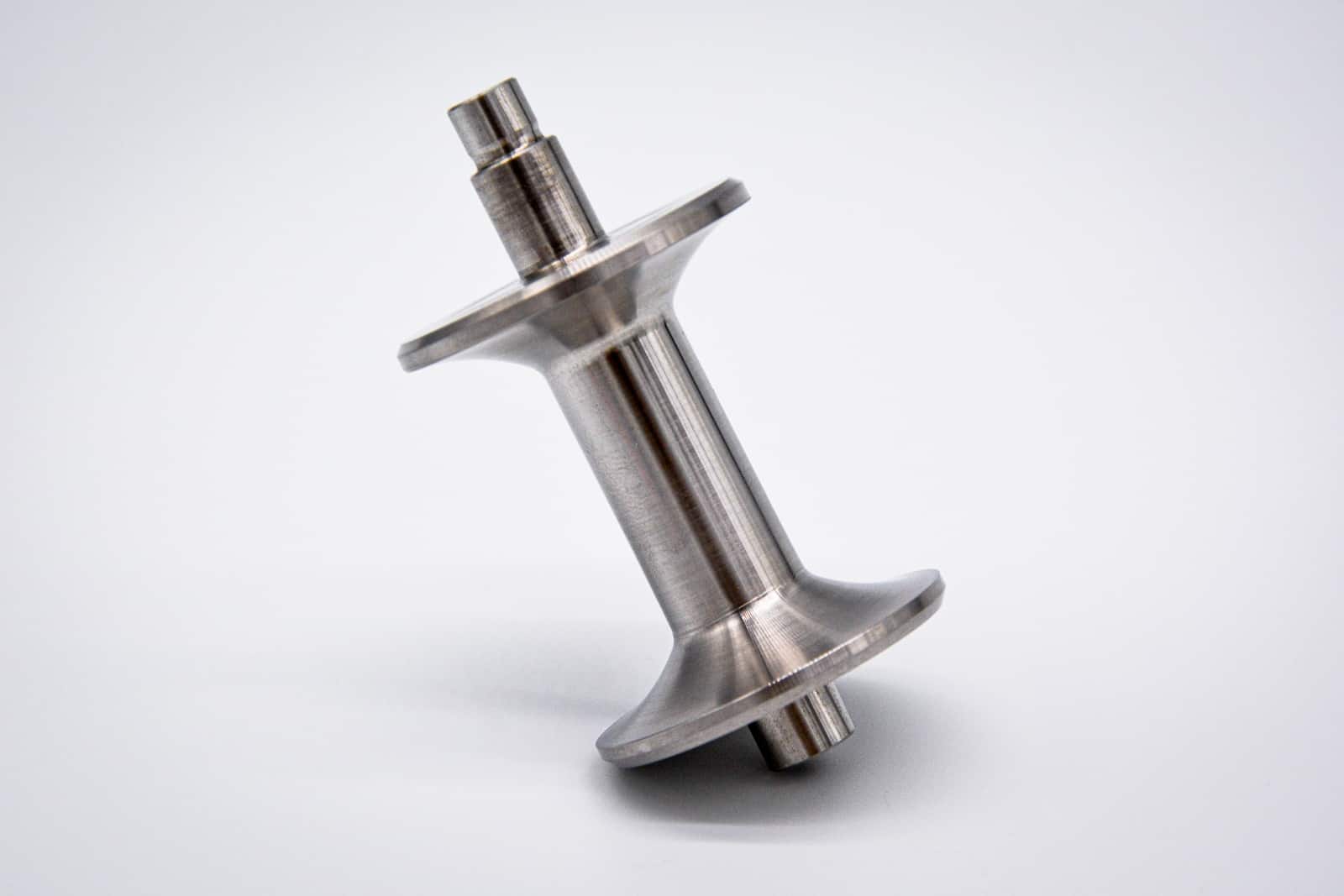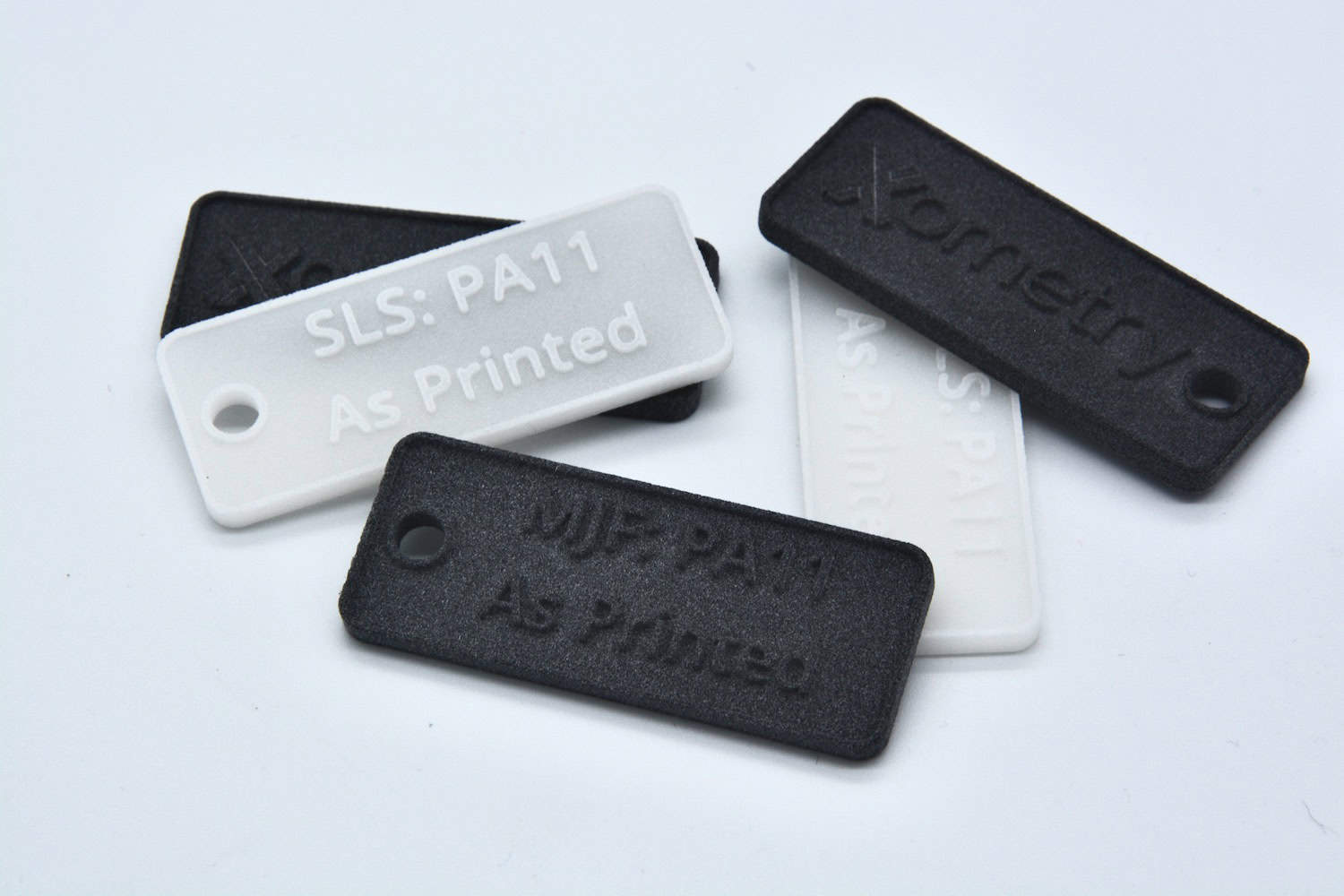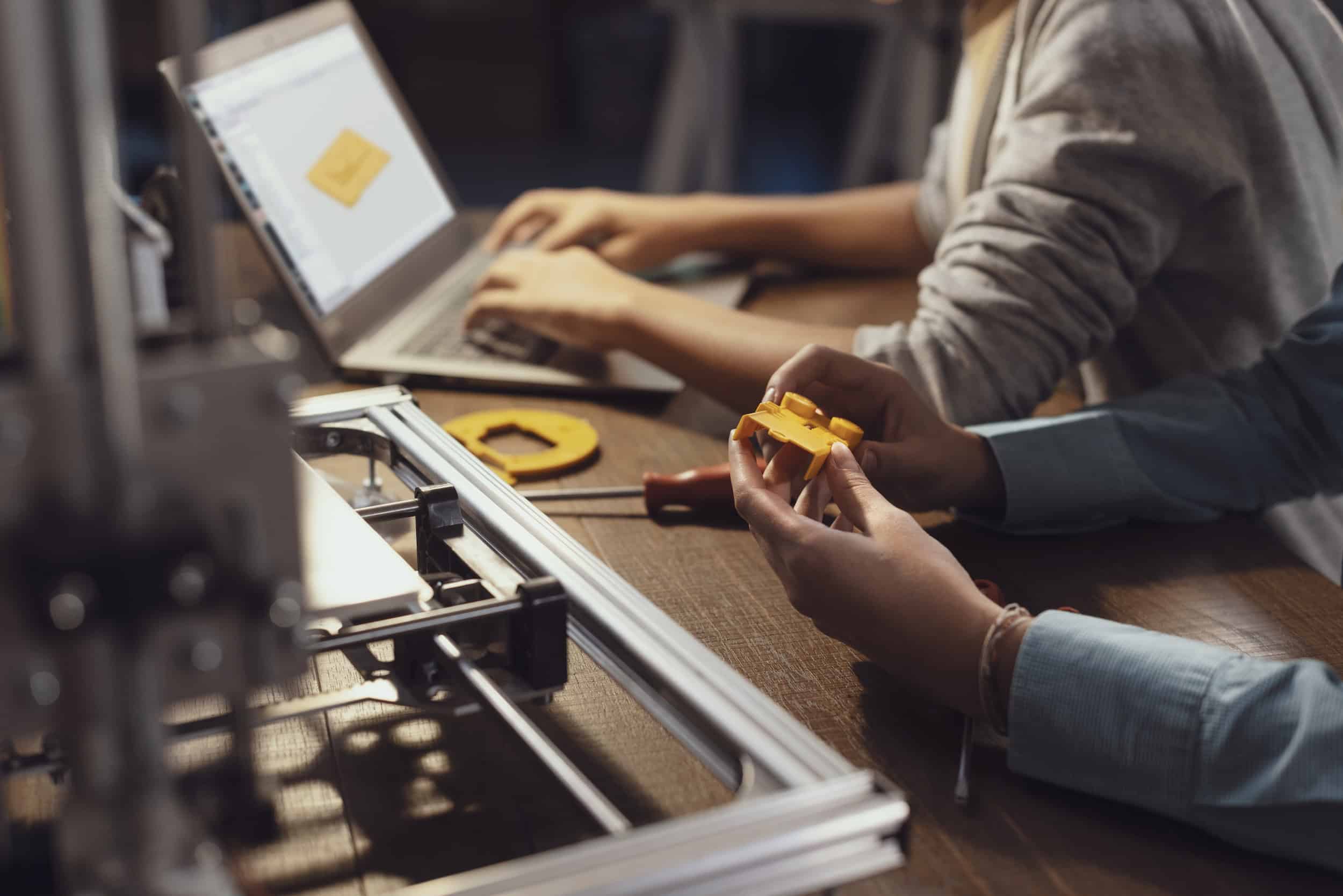To manufacture high-quality products, it is crucial to use appropriate CNC machining materials. Making the correct choice might save you both time and money. This article aims to simplify the process of selecting materials well-suited for CNC machining. This article will look at the many materials that go into CNC machine work.
We have created a list of the CNC machining materials used by Xometry to produce custom CNC machined parts. Most CNC machining involves aluminium, stainless steel, steel, brass, copper, titanium, and rigid plastic.
Aluminium Alloys
Aluminium alloys are the workhorse of CNC machined components. Thanks to their lightweightand excellent thermal conductivity, these materials maximize efficiency and make producing high-precision parts easier.
Aluminium can be heat treated to increase strength, while other additives—such as manganese and silicon—ensure parts created with CNC machining maintain dimensional stability.
As its popularity increases across industries, aluminium is increasingly used in applications ranging from strategic airframes to everyday car components.
Aluminium 2007 / 3.1645 / Al-CuMgPb
This particular aluminium alloy has short chips and a copper percentage that falls anywhere in the range of 3.3% to 4.6%. Both high-speed machining and threading are well suited to this material, making it an excellent choice. Copper is not the only element present; magnesium and lead are other components of it.
- Key features: Excellent machinability • Heat treatable • Low weldability • Low corrosion resistance
- Applications: This material is commonly used to produce machine parts, bolts, and nuts. However, its copper content gives it low weldability and low resistance to corrosion.
- See the datasheet
Aluminium 2017A / 3.1325 / Al-Cu4Mg
Aluminium 2017A / Al-Cu4Mg is an age-hardenable wrought alloy with high strength and excellent ductility. Depending on the required use, it can be heat-treated to obtain a wide variety of qualities. For instance, it could be heat-treated to generate a strong and ductile material, making it ideal for structural applications.
- Key features: Ductile • High strength • Excellent workability
- Applications: Its most common use is in the aerospace industry, namely for manufacturing structural components that require a high strength-to-weight ratio.
- See the datasheet
Aluminium 5083 / 3.3547 / Al-Mg4.5Mn
Aluminium 5083 is a medium-strength, corrosion-resistant alloy. It possesses the strongest strength among the non-heat-treatable alloys, but its usage at temperatures exceeding 65°C is not advised. It is resistant to corrosion and is easy to machine. It can be welded using all usual techniques; however, welding in the heat-affected zone of high-strength alloys is not suggested.
- Key features: Moderate strength • Good machinability • Corrosion resistant • Excellent weldability
- Applications: It is often used in manufacturing sheet metal products such as ducting for HVAC systems, kitchen equipment, and light fittings.
- See the datasheet
Aluminium 6060 / 3.3206 / Al-MgSi
Aluminium 6060 is a series 6000 alloy of Al-Mg-Si with moderate strength. This is a low-strength aluminium alloy that can be heat-treated. It offers excellent corrosion resistance, weldability, and cold-forming suitability.
- Key features: Low strength • Heat treatable • Good weldability • Good corrosion resistance
- Applications: It is commonly used to manufacture machined parts for various industries. It is applied in the production of lighting, furniture, flooring, and other engineering applications with no special strength requirement.
- See the datasheet
Aluminium 6061 / 3.3211 / Al-Mg1SiCu
Aluminium 6061 is a precipitation-hardened aluminium alloy composed mostly of magnesium and silicon. It has excellent mechanical qualities and weldability and is widely extruded (second in popularity only to 6063).
- Key features: High strength • Good weldability • Corrosion resistant
- Applications: It is also commonly used in forging applications. With a tensile strength of 180 Mpa, this high-strength alloy is very suitable for highly loaded structures such as scaffolds, rail coaches, and machine and aerospace parts.
- See the datasheet
Aluminium 6082 / 3.2315 / Al-Si1Mg
Aluminium 6082 comprises magnesium, silicon, iron, manganese, and chromium, among other components. This elemental composition confers the alloy with its distinctive set of features. This alloy is typically manufactured by rolling and extrusion and has moderate strength, excellent weldability, and high heat conductivity. It is resistant to high-stress corrosion cracking. The tensile strength of the material varies between 205 and 310 MPa.
- Key features: Good thermal conductivity • Good weldability • High-stress corrosion cracking resistance
- Applications: It is heavily employed in offshore construction and containers.
- See the datasheet
Aluminium 7075 / 3.4365 / Al-Zn6MgCu
Aluminium 7075 is an alloy of aluminium that has been strengthened with zinc and magnesium. It has excellent resistance to stress corrosion cracking and has high strength. It is the primary component that makes up the alloy. It possesses a high strength (540 MPa), hardness and resilience to fatigue. Milling and brushing are two different surface finishing methods. It is possible to machine it to a significant degree.
- Key features: High strength • Tough • Resistant to fatigue • Excellent machinability
- Applications: With a density of only 2.81 g/cm³, it is also one of the lightest alloys in commercial production. It is extensively used in the structural parts of aircraft.
- See the datasheet
Aluminium Alloys Mechanical Properties Comparison Chart
| Alloy | Yield strength (MPa) | Tensile strength (MPa) | Elongation at break (%) | Hardness | Modulus of elasticity (GPa) |
| Aluminium 2007 / 3.1645 / Al-CuMgPb | 210 – 250 | 370 | 6 – 8 | 130 | 72.5 |
| Aluminium 2017A / 3.1325 / Al-Cu4Mg | 135 – 240 | 250 – 370 | 8 – 12 | 45 – 105 | 72.5 |
| Aluminium 5083 / 3.3547 / AlMg4,5Mn | 115 – 200 | 270 – 345 | 16 | 81.5 | 71 |
| Aluminium 6060 / 3.3206 / Al-MgSi | 60 – 160 | 120 – 215 | 6 – 16 | 45 – 70 | ~70 |
| Aluminium 6061 / 3.3211 / Al-Mg1SiCu | 110 – 240 | 180 – 260 | 7 – 15 | 65 – 85 | 70 |
| Aluminium 6082 / 3.2315 / Al-Si1Mg | 110 – 260 | 205 – 310 | 6 – 15 | 65 – 95 | 70 |
| Aluminium 7075 / 3.4365 / Al-Zn6MgCu | 145 – 475 | 275 – 540 | 2 – 10 | 55 – 163 | 72 |
Stainless Steel Grades
Stainless steel is an incredibly popular material in CNC machining, and different grades are suited to different applications. Many grades of stainless steel are available, with austenitic being the most commonly used for machining processes.
Austenitic materials have good corrosion resistance and a wide range of mechanical strength from soft to tough, perfect for CNC machining work such as turning, threading, drilling and milling.
Stainless Steel 303 / 1.4305 / X10CrNiS18-9
It is an austenitic chromium-nickel stainless steel to which sulfur has been added. The outcome is a material with enhanced machinability but decreased corrosion resistance. X10CrNiS18-9 is a reasonably robust material in terms of its mechanical qualities. It is also very ductile, having a break elongation of around 31%.
- Key features: High strength • Good machinability • Ductility • Low corrosion resistance
- Applications: This material is ideal for use in environments where corrosion is not a major concern, such as in the food processing industry.
- See the datasheet
Stainless Steel 304 / 1.4301 / X5CrNi18.10
V2A stainless steel is an austenitic chromium-nickel alloy. It is also known as 18/8 stainless steel. This is austenitic chromium-nickel stainless steel. The element chromium provides good corrosion resistance. The tensile strength ranges between 500 and 700 MPa. It is machinable but has low thermal conductivity.
- Key features: Excellent corrosion resistance • Low thermal conductivity • Good machinability
- Applications: It is used in kitchen equipment such as pans, tubes, sinks, and many more. It is easily formable. Due to its excellent corrosion resistance, it is widely used in the food and beverage industry and in many other industries.
- See the datasheet
Stainless Steel 316L / 1.4404 / X2CrNiMo17-12-2
It is an austenitic alloy of chromium and nickel, including molybdenum and nitrogen. This mix of components gives it durability and a variety of other desired qualities. The inclusion of molybdenum improves corrosion resistance and stability against nonoxidizing and chloric acids. It has a high heat resistance that decreases with extended usage from 425 to 861 degrees Celsius in water. It is easily formable into many products.
- Key features: Good heat resistance • Corrosion resistance • High weldability
- Applications: It has good machinability and is used in food processing equipment, boat fittings, bolts, nuts, and springs.
- See the datasheet
Stainless Steel 316Ti / 1.4571 / X6CrNiMoTi17-12-2
Stainless steel 1.4571 is an austenitic stainless steel containing both chromium and nickel. The inclusion of these elements improves the corrosion resistance and mechanical strength of the steel. This substance comprises between 0.5 and 0.75 per cent titanium. Titanium provides the steel with a structure that is stable at temperatures exceeding 800°C. It has exceptional corrosion resistance. It is machinable but cannot be heat-treated to increase its hardness.
- Key features: Excellent corrosion resistance • Low hardenability • Excellent durability • High strength
- Applications: It is available as sheets, tubes, pipes, plates, or bars. It is good for marine environments.
- See the datasheet
Stainless Steel 304L / 1.4307 / X2CrNi18-9
Steel 1.4307 / X2CrNi18-9 is an austenitic chromium-nickel stainless steel with molybdenum added to increase corrosion resistance and toughness.
- Key features: Excellent ductility • Non-magnetic • Tough • Strong • Corrosion resistant
- Applications: The steel is non-magnetic and has excellent ductility, making it suitable for various applications such as pressings, drawn components, and welded fabrications. This material is also commonly used in the food and chemical industries and the construction and offshore sectors.
- See the datasheet
Stainless Steel Alloys Technical Properties Comparison Chart
| Alloy | Yield strength (MPa) | Tensile strength (MPa) | Elongation at break (%) | Hardness | Modulus of elasticity (GPa) |
| Stainless Steel 303 / 1.4305 / X10CrNiS18-9 | 351 | 398 | 31% | 234 | 562 |
| Stainless Steel 304 / 1.4301 / X5CrNi18.10 | 260 – 270 | 520 – 680 | ≥ 45 | 215 | 200 |
| Stainless Steel 316L / 1.4404 / X2CrNiMo17-12-2 | 225 | 500 – 700 | 35 – 45 | 215 | 200 |
| Stainless Steel 316Ti / 1.4571 / X6CrNiMoTi17-12-2 | 235 | 500 – 700 | 30 – 40 | 215 | 200 |
| Stainless Steel 304L / 1.4307 / X2CrNi18-9 | 175 – 210 | 500 – 700 | 45 | 215 | 193 |
Steel Grades
CNC machining is a unique process that requires the use of powerful and reliable material components. Steel grades, specifically, play a major role in this process as they define the finished product’s integrity, durability, and accuracy.
For CNC machining applications, high-grade steel is often used as it holds excellent tensile strength and has superior welding ability.
Steel 1.0038 / S235JR
This is structural steel made from pure hot-rolled steel. With superior plasticity, tensile strength, and weldability, its yield strength ranges from 185 to 235 MPa. It is the same as Fe360B. S235JR material can be applied to any steel with comparable chemical and mechanical characteristics.
- Key features: Good plasticity •Tough • Good weldability
- Applications: This material can be formed into many products such as I beam, channels, plates, angle bars, etc. its excellent weldability makes it widely used in bridges, transmission towers, etc.
- See the datasheet
Steel 1.0503 / C45
Steel C45 is the designation given to steels with a carbon content between 0.42 and 0.50 weight per cent. This material has the lowest heat conductivity and ductility among carbon steels that have been wrought. In high-speed applications, size precision, straightness, and concentricity lead to little wear.
- Key features: High tensile strength • Low ductility • Low thermal conductivity
- Applications: While medium carbon steels are used in various applications, they are particularly well suited for parts that require high wear resistance and strength, such as gears, shafts, and bearings.
- See the datasheet
Steel 1.0511 / C40
This steel is a non-alloyed carbon engineering steel that has been wrought and heat-treated to increase its hardness. It is suited for situations requiring great strength. Steel 1.0511 / C40 is a carbon steel of unalloyed grade with high tensile strength, so it is appropriate for applications requiring strength.
- Key features: Excellent strength • High machinability • Non-alloyed
- Applications: This steel grade is available in various profiles, including plates, sheets, coils, strips, bars, and forgings. This steel grade is typically used in automotive components, machinery parts, pump and valve bodies, gears, and spindles.
- See the datasheet
Steel 1.0570 / S355J2G3
This steel contains many chemical elements, each of which confers distinct qualities. For example, st52 steel is renowned for its strength and durability. It is also corrosion-resistant and readily weldable. These
characteristics make it a great material for several applications. This unalloyed structural steel has a tensile strength of 630Mpa. Compared to other carbon steels, this material has a high electrical conductivity but low heat conductivity and ductility.
- Key features: High tensile strength • Low thermal conductivity • Good weldability • Low ductility
- Applications: This steel has many applications, including gearboxes, socket components in shipbuilding, tappets, roller bodies, and many more.
- See the datasheet
Steel 1.2842 / 90MnCrV8
Steel 1.2842 / 90MnCrV8 is a chromium-molybdenum-vanadium alloy with a high carbon content. The material provides excellent durability and wear resistance. In addition, it possesses excellent machinability and is non-magnetic. The steel’s hardness can be increased by heat treatment.
- Key features: Tough • High machinability • Wear resistant • Non-magnetic
- Applications: It is used for making cutting tools and measuring implements. The material is also suitable for cold-forming operations such as bending, stamping, and drawing.
- See the datasheet
Steel 1.7131 / 16MnCr5
Carbon steel 1.7131 has excellent weldability and machinability. It has a high surface hardness and wear resistance and is easily machined. This material’s mechanical characteristics can be altered by heat treatment.
- Key features: High surface hardness • Wear resistance • High machinability and weldability.
- Applications: It is suitable for manufacturing parts and components that require good dimensional stability and mechanical properties. With a tensile strength of 640 –1375 MPa, it is ideal for manufacturing gears, worms, bushings, and other machine components.
- See the datasheet
Steel 1.7218 / 25CrMo4
25CrMo4 is a steel grade intended particularly for producing components and parts susceptible to high degrees of stress. This type of steel is renowned for its high strength and resiliency, making it a perfect material for situations in which endurance is essential.
- Key features: Durable • Excellent strength and resilience
- Applications: It is generally used to manufacture gears, shafts, valves, and other highly stressed components.
- See the datasheet
Steel 1.7225 / 42CrMo4
Steel 1.7225 is a typical German material supplied in a pre-hardened state. It produces different plastic moulds, hot forging dies, and hot stamping dies. Additionally, the material may be utilized to create cold
work tool steels. This material offers exceptional strength, toughness, hardenability, and impact resistance.
- Key features: High strength • Tough • Resistance to impact • Hardenability
- Applications: It is widely used in the construction of machines, axles, gear shafts, wheel and base plates. It is also used for the production of large plastic moulds.
- See the datasheet
Steel Materials Mechanical Properties Comparison Chart
| Material | Yield strength (MPa) | Tensile strength (MPa) | Elongation at break (%) | Hardness | Modulus of elasticity (GPa) |
| Steel 1.0038 / S235JR | 185 – 235 | 340 – 510 | 21 – 26 | 120 | 210 |
| Steel 1.0503 / C45 | 275 | 560 | 16 | 255 | 205 |
| Steel 1.0511 / C40 | 285 | 482 | 21 | 322 | 372 |
| Steel 1.0570 / S355J2G3 | 315 – 355 | 490 – 630 | 22 | 217 | 210 |
| Steel 1.2842 / 90MnCrV8 | 739 | 914 | 14 | 334 | 386 |
| Steel 1.7131 / 16MnCr5 | 440 – 735 | 640 – 1375 | 8 – 15 | 207 | 190 – 210 |
| Steel 1.7218 / 25CrMo4 | 345 – 700 | 600 – 1100 | 12 – 16 | 212 – 255 | 210 |
| Steel 1.7225 / 42CrMo4 | 500 – 900 | 750 – 1300 | 10 – 14 | 219 | 164 – 217 |
Titanium Grades
Amongst metals, titanium is considered one of the toughest yet lightweight materials for CNC machining. This makes it an excellent choice when precision engineering is needed. Different grades of titanium can be used, depending on the desired strength and further characteristics.
No matter which grade you choose, rest assured that CNC machining titanium parts are long-lasting and suitable options for building durable components while keeping the weight low.
Titan Grade 2 / 3.7035
This unalloyed titanium offers an exceptional strength-to-weight ratio and high corrosion resistance. Limited thermal stresses result from its low thermal expansion. Due to its exceptional biocompatibility, it is commonly used in lightweight constructions and is also applicable in the medical field.
- Key features: Excellent strength-to-weight ratio • Good resistance to corrosion • Low thermal expansion
- Applications: This titanium grade is often used for structural components such as frames, wings, and fuselage. Other common applications include turbine blades, shafts, and fasteners.
- See the datasheet
Titan Grade 5 / 3.7164 / 3.7165 / Ti-6Al-4V
This material comprises 6.75 per cent aluminium, 4.5 per cent vanadium, and trace quantities of iron. It has more strength than pure titanium while retaining the same rigidity and thermal characteristics. It can be easily machined and welded.
- Key features: Good strength • Easy machinability • Resistant to corrosion
- Applications: With high strength and corrosion resistance, it can withstand various adverse environmental factors, including seawater. It is often used in subsea oil and gas structures.
- See the datasheet
| Alloy | Yield strength (MPa) | Tensile strength (MPa) | Elongation at break (%) | Hardness | Modulus of elasticity (GPa) |
| Titan Grade 2 / 3.7035 | 275 – 410 | 345 | 20 | 150 | 105 |
| Titan Grade 5 / 3.7164 / 3.7165 / Ti-6Al-4V | 830 | 895 | 10 | 310 | 114 |
Brass Grade
CNC machining with brass provides various benefits for automotive and marine engineering applications. Additionally, its special properties make it recyclable without losing material quality, making brass an ideal choice for sustainable projects.
Brass Ms58 / 2.0401 / CuZn39Pb3
It is a copper-zinc alloy that is renowned for its strength and endurance. This material is readily soldered and brazed and has great hot formability. It has excellent freedom of cutting. It has many benefits over other materials, including its resistance to corrosion and inexpensive cost.
- Key features: Excellent hot formability • Good free-cutting • Excellent machinability
- Applications: Brass Ms58 is often used to produce plumbing fixtures, door hardware, and musical instruments. It is also suitable for use in the sanitary industry, engine and vehicle construction, and swivel parts.
- See the datasheet
Copper Grade
Copper is an excellent choice for CNC machining because of its high strength-to-weight ratio and impressive heat conductivity. When precision parts are made by CNC machining, copper is known to provide a higher level of accuracy than other metals, making it the preferred choice in many industries.
Copper E-Cu57 / 2.0060 / E-Cu58 / 2.0065
It is renowned for its excellent conductivity and corrosion resistance. Thus, it is a good material for electrical wiring and other electrical applications. Its excellent machinability makes it simple to mould into many shapes, including profiles, sheets, and plates.
- Key features: High conductivity • Good machinability • Durable • Flexible
- Applications: It is heavily used in the electrical/electronics industry. It is a very strong metal, which means it can withstand a lot of wear and tear.
- See the datasheet
Rigid Plastic Materials
Rigid plastic materials are widely used in CNC machining applications due to their relative affordability and versatility. These plastics can be cut, machined, drilled, and manipulated using CNC equipment without losing strength or durability.
Rigid plastic materials are also more economical than metal alternatives and can be cut and formed more precisely for better functional part performance.
ABS
This thermoplastic material is renowned for its exceptional impact resistance and tensile strength. In addition, it is scratch-resistant, robust, and has a low melting point and excellent weldability.
- Key features: High rigidity and dimensional stability • Resistant to impact and scratches
- Applications: With a high strength–to–weight ratio, it is suitable for injection moulding. It is used in the manufacturing, automotive, and marine industries.
- See the datasheet
Acrylic
This material is the most common form of transparent thermoplastic that can be moulded and is often substituted for glass owing to its superior resistance. It is resistant to weather and chemicals and has an acceptable surface hardness.
- Key features: Hard • Resistant to weather and chemicals • Transparent • Durable
- Applications: Acrylic has easy moldability and can be formed into various shapes and sizes. It is used for transparent applications such as windows, frames, etc.
- See the datasheet
PC (Polycarbonate)
This naturally translucent plastic has exceptional impact resistance and strength. It is resistant to shattering and heat. It consists of a combination of bisphenol A (BPA) and phosgene. It possesses a high degree of rigidity and viscosity.
- Key features: Transparent • Durable • Shatter resistant • Good electrical properties
- Applications: PC is generally easy to work with and is used in applications such as food and beverage packaging, medical devices, eyewear, electronics, and construction materials.
- See the datasheet
PEEK
PEEK is tough, rigid, and has high strength. At increased temperatures, it retains its chemical resistance. In addition, its resistance to fatigue, stress-cracking, high-pressure water, and steam is exceptional. PEEK is also resistant to radiation and has a low friction coefficient.
- Key features: Hard • High mechanical strength • Resistant to chemicals and fatigue
- Applications: It produces components such as tubes, bearings, seals, valves, electric insulation,and even medical implants.
- See the datasheet
PEEK Glass-filled
PEEK glass-filled material is a form of plastic with glass fibre reinforcement. It is sturdy and rigid, making it a perfect material for applications that need these characteristics. In addition to being resistant to heat and chemicals, it is a suitable material for usage in harsh conditions.
- Key features: Stiff • Durable • Resistant against chemicals • Heat-resistant
- Applications: This material can be used in various applications, including medical devices, automotive parts, and electrical components.
- See the datasheet
Polypropylene (PP)
Polypropylene is made by combining Polyol with Isocyanate in a 1:2 ratio. It has a transparent black-and-white appearance. Because of its excellent elongation capabilities, this material is often utilized to create elastic parts.
- Key features: Low flexural modulus • High elongation • Long pot life• Suitable for moulding large-sized products
- Applications: It is often used to produce prototypes and products of PP or PE.
- See the datasheet
POM / Delrin acetal
This material is an easy-to-mould resin. It possesses a reasonably high tensile strength and resistance to wear, creep, and deformation. It is typically sturdy and resilient, with little water absorption. Additionally, it is chemically resistant to hydrocarbons and solvents.
- Key features: Durable • Strong • Resistant to wear, creep and warp
- Applications: It is used for a wide range of industrial and mechanical parts such as pumps, valves, bearings, fittings, etc.
- See the datasheet
PTFE / Teflon
This material is very slippery and resistant to harsh temperatures. It has exceptional insulating characteristics and chemical resistance. The density and rigidity of Teflon make it easily machinable. However, the material’s high coefficient of expansion and stress creep make it challenging to achieve close tolerances.
- Key features: Slippery • Resistant to extreme temperatures • Low friction, thermal and electrical insulator
- Applications: Due to its low coefficient of friction, it is widely used in producing gears, bushings, slide plates, piston rings, etc.
- See the datasheet
PVDF / Polyvinylidene fluoride
Polyvinylidene fluoride, sometimes known as PVDF, is a fluorine-based material. It is made from units of vinylidene difluoride that are repeated over and over again. It can be pulled into thin strands and has a high tensile strength.
- Key features: High strength • Chemical resistant • Self-lubricating
- Applications: It has good chemical resistance and self-lubricating properties. This material is used in a variety of applications, including electrical insulation, automotive parts, and medical devices.
- See the datasheet
UHMW PE / Ultra-high-molecular-weight polyethene
It is a thermoplastic composed of ultrafine polyethene particles. It is used in various applications that need excellent wear resistance, low friction, and impact resistance. This material is exceptionally durable and resistant to abrasion and wear. It is resistant to corrosion and self-lubricating. It has superior mechanical qualities even in subzero temperatures.
- Key features: Self-lubricating • Resistant to abrasion • Corrosion resistant • Durable • Low coefficient of friction
- Applications: It is used in conveyor guides, wear pads, chemical tanks, etc. it is available in either sheet or rod form and has easy machinability.
- See the datasheet
| Alloy | Tensile modulus (MPa) | Tensile strength (MPa) | Elongation at break (%) | Flexural strength (MPa) | Flexural modulus (GPa) | Hardness |
| ABS | 2270 | 46 | 48 | 69 | 23.5 | 68 – 118 |
| Acrylic | 2413 – 3447 | 55.1 – 75.8 | 2 | 82.7 – 117.2 | 5.51 – 7.58 | 98 |
| PC (Polycarbonate) | 2206 | 65.5 | 60 | 103.4 | 2.58 | 95 |
| PEEK | 3792 | 99.9 | 35 | 165.4 | 4.13 | 230 |
| PEEK glass-filled | 6205.2 | 103.4 | 3 | 193 | 6.89 | – |
| Polypropylene (PP) | 1600 | 30 | 150 | 40 | 1.5 | 70 |
| POM / Delrin acetal | 3102 | 75.8 | 30 | 89.6 | 3.1 | 150 |
| PTFE / Teflon | 551.5 | 26.88 | 300 | 14 | 0.49 | 57 |
| PVDF / Polyvinylidene fluoride | 2000 | 55 | 20 | – | 0.89 | 77 |
| UHMW PE / Ultra-high-molecular-weight polyethene | 551.5 | 39.9 | 300 | 25.13 | 0.606 | 64 |
Get Your Custom CNC-machined Parts from Xometry
Selecting the right material can be a time-consuming process. If you need anything CNC machined, go no further than Xometry. To meet the needs of each CNC machining project, the firm offers a wide range of materials with a variety of mechanical properties. After uploading your files, you can obtain a quotation in seconds with the Xometry Instant Quoting Engine, and you can play around with different materials to see how they affect the price.
 Europe
Europe  Türkiye
Türkiye  United Kingdom
United Kingdom  Global
Global 

 Login with my Xometry account
Login with my Xometry account  0
0








